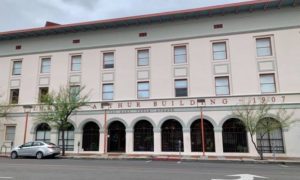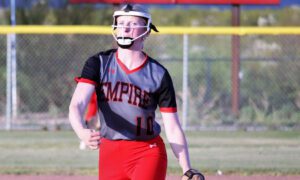FOLLOW @JAVIERJMORALES ON TWITTER!
[rps-paypal]

The front page of the Chicago Daily Tribune sports page showing the first game played at what is now known as Wrigley Field in 1914
[ezcol_1half id=”” class=”” style=””]

|
TABLE OF CONTENTS: — General history — J.F. “Pop” McKale — The games — Comparisons then and now — Wildcats nickname — Military service — Rankings |
LAST WEEK: — No. 62: Chain events leading to World War I begin — No. 63: Three yards, cloud of dust prevailed in 1914 — No. 64: 1964 homecoming celebration — No. 65: Color barrier broken in 1949 — No. 66: Three members of team also part of band — No. 67: Majority of team came from other parts of country — No. 68: Top 10 Arizona moral victories |
[/ezcol_1half]
[ezcol_1half_end id=”” class=”” style=””]
Clipping of actual L.A. Times article published Nov. 8, 1914
Excerpt from L.A. Times, Nov. 8, 1914, authored by Bill Henry:
“Arizona’s cactus-fed athletes, despite heroic efforts on the part of their two halfbacks, (Asa) Porter and (Franklin) Luis, went down to defeat before the Occidental Tigers yesterday afternoon, the tally with all precincts heard from being 14 to 0 in favor of the Tigers.
Confident of rolling up a big score, the Tigers took the field with grins on their faces, but before the game was 10 seconds old they knew they had a battle on their hands.
The Arizona men showed the fight of wild cats and displayed before the public gaze a couple of little shrimps in the backfield who defied all attempts of the Tigers to stop them.”This site will conduct a countdown in a 100-day period, leading up to Arizona’s 2014 football season-opener with UNLV on Aug. 29 at Arizona Stadium. The 100 Days ‘Til Kickoff countdown will include information daily about the historic 1914 Arizona team that helped create the school’s nickname of “Wildcats” because of how they played that fateful day against Occidental.
[/ezcol_1half_end]
[ezcol_1half id=”” class=”” style=””]
If you have kept up with our series on the 100-year anniversary of Arizona becoming the “Wildcats”, you know of that development and the beginning of World War I in 1914.
You also know by now that this is the 100-year anniversary of J.F. “Pop” McKale’s hiring at Arizona. This year also marks the 100th anniversary of Arizona’s homecoming celebration, which began with an inspirational 7-6 win over Pomona College on Thanksgiving Day in 1914.
The victory sparked the idea for Arizona player Albert Condron, an engineering student, to approach his professors about putting an “A” on Sentinel Peak in Tucson. Hence, the concept of “A” Mountain, completed in 1916, was born 100 years ago.
The series has also taught you of other important developments in Tucson 100 years ago, including the first pavement of a street in the city, downtown.
[/ezcol_1half]
[ezcol_1half_end id=”” class=”” style=””]
[/ezcol_1half_end]
Nationally, significant developments started in 1914, including the illustrious baseball career of Babe Ruth.
Other 100-year anniversaries celebrated this year:
— The opening of Wrigley Field in Chicago. The field was called Weeghman Park when it opened its doors and it was home to the Chicago Whales of the Chicago Federal League. Charles Weeghman, a wealthy Restaurateur, was the owner of the Whales and funded the building of the park. The Chicago Cubs, who played at the West Side Park, did not move into Weeghman Park until 1916. Weeghman became Cubs Park in 1920 and then Wrigley Field in 1926. An overflow crowd of 21,000 (the capacity of the park was 18,000) saw the first game at Weeghman between the Whales and the Kansas City Packers on April 23, 1914. Chicago won 9-1. As fate would have it, legendary Cubs announcer Harry Caray was born in 1914, three days after ground-breaking ceremonies for the park.

The 1914 Arizona football team that earned the honor of being named the first “Wildcats” was composed of (front row, left to right): Verne La Tourette, George Seeley, Leo Cloud, Richard Meyer, Asa Porter. Second row: Franklin Luis, Lawrence Jackson, Ray Miller, J.F. “Pop” McKale (coach), Turner Smith, Harry Hobson (manager), Orville McPherson, Albert Crawford, Ernest Renaud. Back row: Albert Condron, Emzy Lynch, Charley Beach, Vinton Hammels, Bill Hendry, George Clawson, Harry Turvey.
(AllSportsTucson.com graphic/Photo from University of Arizona Library Special Collections)
[ezcol_1half id=”” class=”” style=””]
What they were talking about on this day in 1914
Monday, June 29, 1914
A near-riot occurred at the Chicago Cubs-Cincinnati Reds game at Wrigley Field, which opened 100 years ago this season. This occurred after umpire Mal Eason ejected Cincinnati third-base coach Dick Hoblitzel for arguing that a ruled foul ball off the bat of Herbie Moran was actually touched first by Cubs third baseman Heinie Zimmerman. Eason then ejected Reds player-manager Buck Herzog and four other players after they stormed from the dugout. Herzog became so enraged he threw Moran’s bat into the stands near third base. One of the fans stormed the field to confront Herzog. The fan was restrained and cooler heads prevailed. Moments later, Herzog approached the man and the other fans in the stands to apologize. He was then sent to the showers along with Hoblitzel and the four players who charged the field. The Reds lost 10-7.
[/ezcol_1half]
[ezcol_1half_end id=”” class=”” style=””]
[/ezcol_1half_end]

The first commercial flight over the bay from St. Petersburg to Tampa, Fla., in 1914 (University of South Florida photo)
— The first scheduled commercial airline flight. It took place on New Year’s Day in 1914, a short trip across the bay from St. Petersburg to Tampa, Fla. It took 23 minutes. Tony Jannus piloted a Benoist flying boat with Abram C. Pheil, the former Mayor of St. Petersburg, as his passenger. Pheil paid $400 at an auction to become the first passenger. The airline operated two scheduled roundtrips daily across Tampa Bay. Regular one-way fare was $5.00 With average air speeds of 60 miles per hour.
— The opening of the Panama Canal. It officially opened Aug. 15, 1914. One of the largest and most difficult engineering projects ever undertaken (it took 10 years to complete), the Panama Canal shortcut greatly reduced the amount of time taken for ships to travel between the Atlantic and Pacific Oceans (avoiding having to travel past the southernmost tip of South America). The shorter, faster, and safer route to the U.S. West Coast and to nations in and around the Pacific Ocean allowed those places to become more integrated with the world economy.
— The first Mother’s Day. On May 9, 1914, President Woodrow Wilson issues a presidential proclamation that officially establishes the first national Mother’s Day holiday to celebrate America’s mothers. Many individual states celebrated Mother’s Day by 1911, but it was not until Wilson lobbied Congress in 1914 that Mother’s Day was officially set on the second Sunday of every May.
— The world’s first electronic traffic signal was installed. It was put into place on the corner of Euclid Avenue and East 105th Street in Cleveland, Ohio, on Aug. 5, 1914. The signal, constructed by inventor Garrett Morgan, consisted of four pairs of red and green lights that served as stop-go indicators, each mounted on a corner post. Wired to a manually operated switch inside a control booth, the system was configured so that conflicting signals were impossible. According to an article in The Motorist, published by the Cleveland Automobile Club in August 1914: “This system is, perhaps, destined to revolutionize the handling of traffic in congested city streets and should be seriously considered by traffic committees for general adoption.”
ALLSPORTSTUCSON.com publisher, writer and editor Javier Morales is a former Arizona Press Club award winner. He also writes articles for Bleacher Report and Lindy’s College Sports.




























